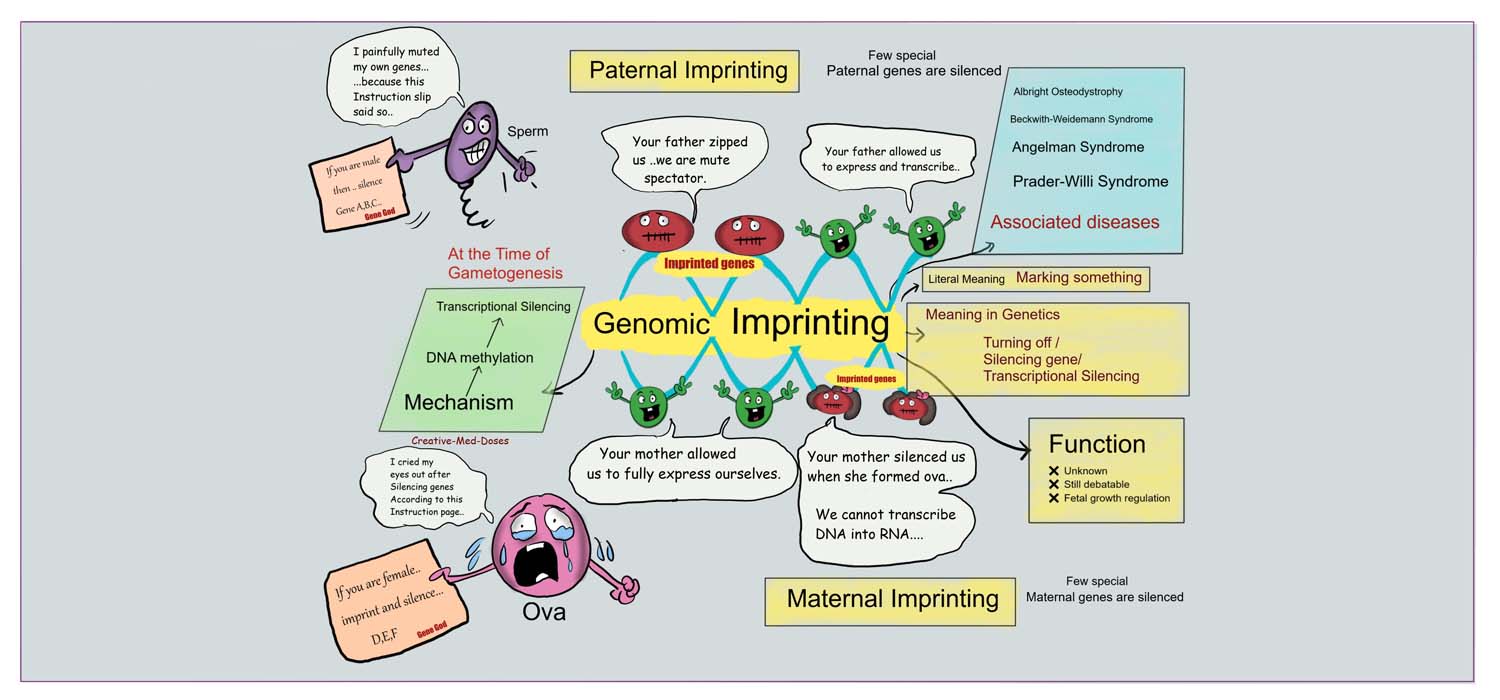Epigenetics and Imprinting Disorders
What is epigenetics?
Epigenetics is the study of mitotically and meiotically heritable changes in gene function that cannot be explained by changes in DNA sequences.
This heritable modification in gene function can be due to environmental factors and may be due to differences in chromosome packaging.
What are epigenetic modifications?
Epigenetic modifications are the various ways in which the gene expression is altered. This includes DNA methylation, Histone modifications, packaging of chromosomes and RNA mediated modifications which cause a change in the expression of genes and hence the phenotype.
What is genomic imprinting?
Genomic imprinting is a modification of the genome, selectively allowing the genes of one parent to be expressed, suppressing the other. The alleles are stamped by epigenetic influences which then continues throughout the pre and peri-implantation phases.
Imprinting does not follow the Mendelian laws of inheritance. 1% of the human genes are associated with imprinting and many of them are associated with pre and postnatal growth.
When does imprinting occur?
Germ cell development and early embryogenesis are the crucial times when the parental imprints are removed, and new imprints are acquired and maintained during the process of embryogenesis.
Which are the conditions that occur due to imprinting disorders?
Imprinting Syndromes are those that result from disturbances in the expression of the genes. One of the parental pair is suppressed completely. The other one is expressed, and this is called parental disomy.
Some examples of such disorders and the chromosome/position that is involved in imprinting include:
Beckwith Weidman Syndrome (11p15)-Paternal disomy, Angelman Syndrome (15q11-q13)- Paternal disomy, Prader Willi syndrome (15q11-q13)- Maternal disomy, Silver-Russel syndrome (11 p15/7p11-p13) Maternal disomy, Mc Cune Albright syndrome (20q13) etc.
Is there an association between ART and imprinting disorders?
The concern that ART processes can cause such imprinting disorders is valid as all these processes occur under artificial conditions in comparison to the ‘in vivo’ environment of spontaneous conceptions.
However, small sample sizes, studies not considering maternal age and cause of infertility have mandated larger studies.
Where then, are the potential risks for imprinting and epigenetics in ART?
- Infertility itself is a potential risk factor for imprinting.
- IVF related manipulations occur at the time when epigenetic mechanisms are active in germ cells.
- Male gametes - Apprehensions exist for the use of immature spermatids, surgically obtained germ cells, frozen-thawed gametes and ICSI involving manipulation of both gametes. However, as theoretically, erasure of old and acquisition of new imprints is completed by spermatid stage, it is unlikely that ART involving male gametes as surgically obtained immature sperms or elongated sperms would interfere with imprinting disorders.
- Female Gamete- Ovulation induction, In vitro Maturation, down regulation, superovulation, culturing and micromanipulation of oocytes and freeze-thawing injuries have been the concerns that may contribute to epigenetic mechanisms.
- Embryo culture- Especially prolonged culture, manipulation and cryopreservation, possible variation in pH, temperature, oxygen concentration are some conditions thought to be contributing.
- ICSI- Disruption of oocyte cytoskeleton, leakage of ooplasm, by passing the natural selections and barriers, abnormal oocyte activation, removal of cumulus, paternal age/ subfertility and genetic factors have all been implicated as possible contributions.
What is the evidence of the association between ART and imprinting disorders?
- BWS (Beckwith Weidman Syndrome) has a definite association with ART. The relative risk is increased by 5.2. (The incidence in general population is 1:13,700 while that after ART is 1: 2700) This occurs due to paternal disomy and maternal deletion of 11p15.5
BWS is characterized by macrosomia, macroglossia, visceromegaly, embryonal tumors (Wilm’s tumor, Hepatoblastoma, Rhabdomyosarcoma), Omphalocele, Neonatal hypoglycemia etc. - Angelman syndrome- 71% of these cases occur after ART and 5% after normal conception. This occurs due to paternal disomy and deletion of maternal chromosome 15q11 to q13.
- No correlation has been found with Prader Willi syndrome and Silver Russel syndrome.
What are the other issues to be addressed about Imprinting for the future of ART?
- Does culturing embryos to blastocyst contribute to increasing the risk of imprinting?
- Does superovulation and hormonal stimulation have a role in DNA methylation?
- Is there risk in cryopreserving gametes and embryos?
- Is it the underlying infertility or ART per se that causes imprinting disorders?
Are there any preventive measures in ART to avoid imprinting disorders?
- Protocols can be modified if the exact triggering points can be identified.
- Appropriate concentrations of essential amino acids in the embryo culture mediums can avoid imprinting.
- Strict control of embryology environment.
To conclude, Epigenetics and Imprinting disorders are issues that need to be addressed in Assisted reproductive technologies and require further studies and reports.
For more info, Visit : www.medlineacademics.com
